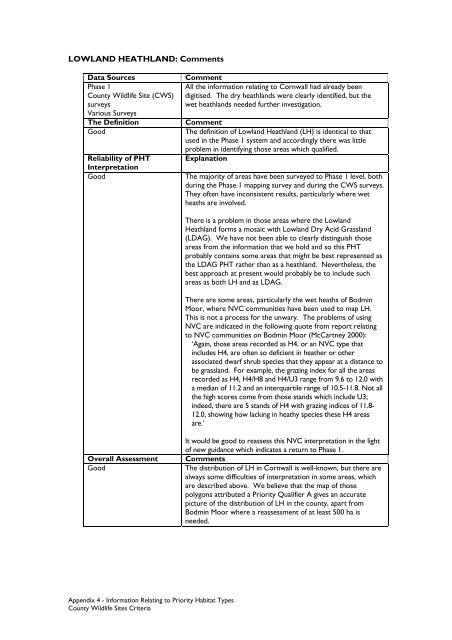County Wildife Site Criteria for Cornwall Appendices
County Wildife Site Criteria for Cornwall Appendices
County Wildife Site Criteria for Cornwall Appendices
You also want an ePaper? Increase the reach of your titles
YUMPU automatically turns print PDFs into web optimized ePapers that Google loves.
LOWLAND HEATHLAND: CommentsData SourcesPhase 1<strong>County</strong> Wildlife <strong>Site</strong> (CWS)surveysVarious SurveysThe DefinitionGoodReliability of PHTInterpretationGoodCommentAll the in<strong>for</strong>mation relating to <strong>Cornwall</strong> had already beendigitised. The dry heathlands were clearly identified, but thewet heathlands needed further investigation.CommentThe definition of Lowland Heathland (LH) is identical to thatused in the Phase 1 system and accordingly there was littleproblem in identifying those areas which qualified.ExplanationThe majority of areas have been surveyed to Phase 1 level, bothduring the Phase 1 mapping survey and during the CWS surveys.They often have inconsistent results, particularly where wetheaths are involved.There is a problem in those areas where the LowlandHeathland <strong>for</strong>ms a mosaic with Lowland Dry Acid Grassland(LDAG). We have not been able to clearly distinguish thoseareas from the in<strong>for</strong>mation that we hold and so this PHTprobably contains some areas that might be best represented asthe LDAG PHT rather than as a heathland. Nevertheless, thebest approach at present would probably be to include suchareas as both LH and as LDAG.There are some areas, particularly the wet heaths of BodminMoor, where NVC communities have been used to map LH.This is not a process <strong>for</strong> the unwary. The problems of usingNVC are indicated in the following quote from report relatingto NVC communities on Bodmin Moor (McCartney 2000):‘Again, those areas recorded as H4, or an NVC type thatincludes H4, are often so deficient in heather or otherassociated dwarf shrub species that they appear at a distance tobe grassland. For example, the grazing index <strong>for</strong> all the areasrecorded as H4, H4/H8 and H4/U3 range from 9.6 to 12.0 witha median of 11.2 and an interquartile range of 10.5-11.8. Not allthe high scores come from those stands which include U3;indeed, there are 5 stands of H4 with grazing indices of 11.8-12.0, showing how lacking in heathy species these H4 areasare.’Overall AssessmentGoodIt would be good to reassess this NVC interpretation in the lightof new guidance which indicates a return to Phase 1.CommentsThe distribution of LH in <strong>Cornwall</strong> is well-known, but there arealways some difficulties of interpretation in some areas, whichare described above. We believe that the map of thosepolygons attributed a Priority Qualifier A gives an accuratepicture of the distribution of LH in the county, apart fromBodmin Moor where a reassessment of at least 500 ha isneeded.Appendix 4 - In<strong>for</strong>mation Relating to Priority Habitat Types<strong>County</strong> Wildlife <strong>Site</strong>s <strong>Criteria</strong>
















